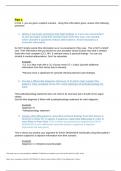Case
NR 511 Case Studies Week 3 And 6 2024/2025
- Course
- Institution
NR 511 Case Studies Week 3 and 6 Part 1 In Part 1, you are given a patient scenario. Using the information given, answer the following questions: Briefly and concisely summarize the H&P findings as if you were presenting it to your preceptor using the pertinent facts from the case. Use shor...
[Show more]



